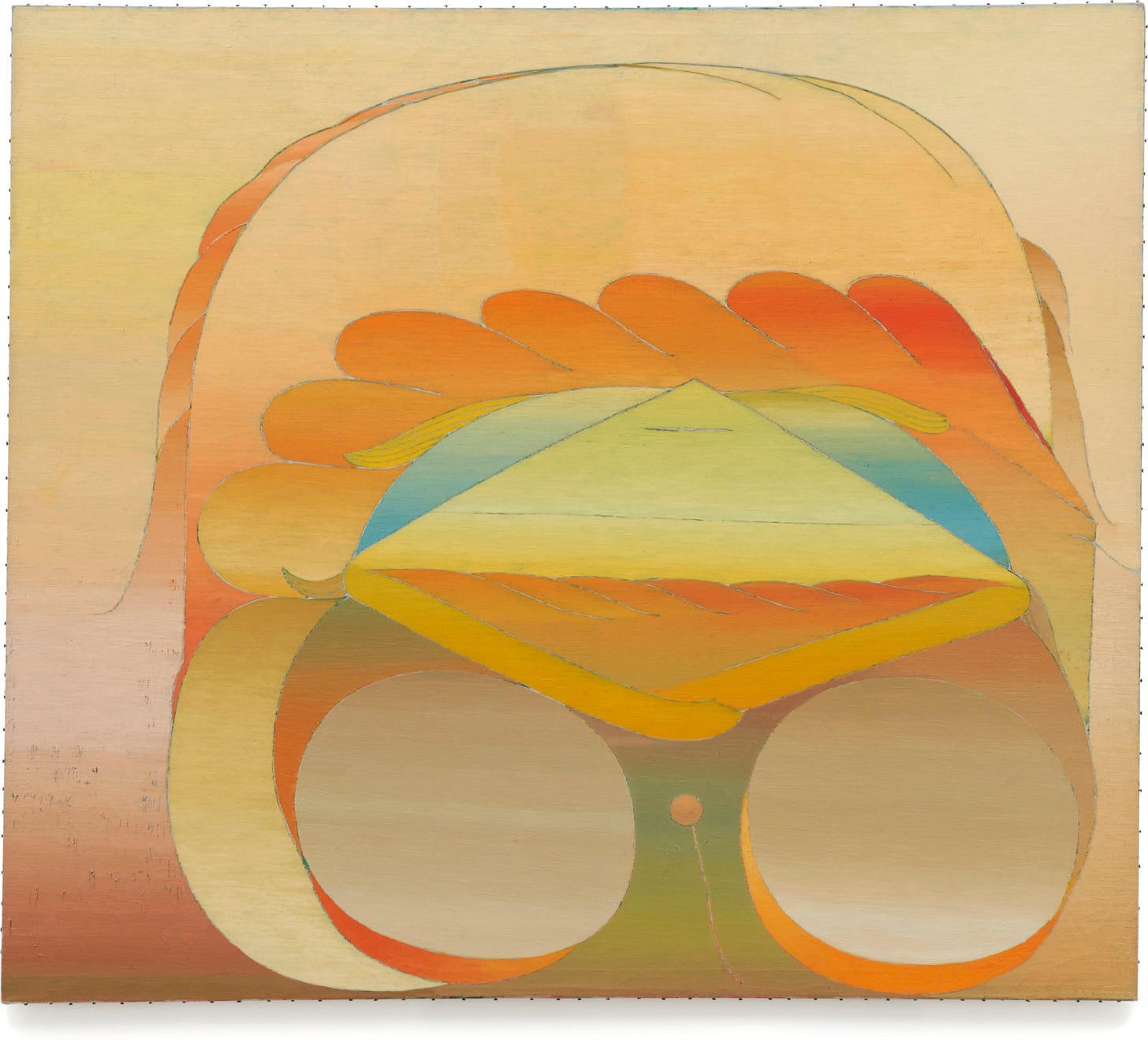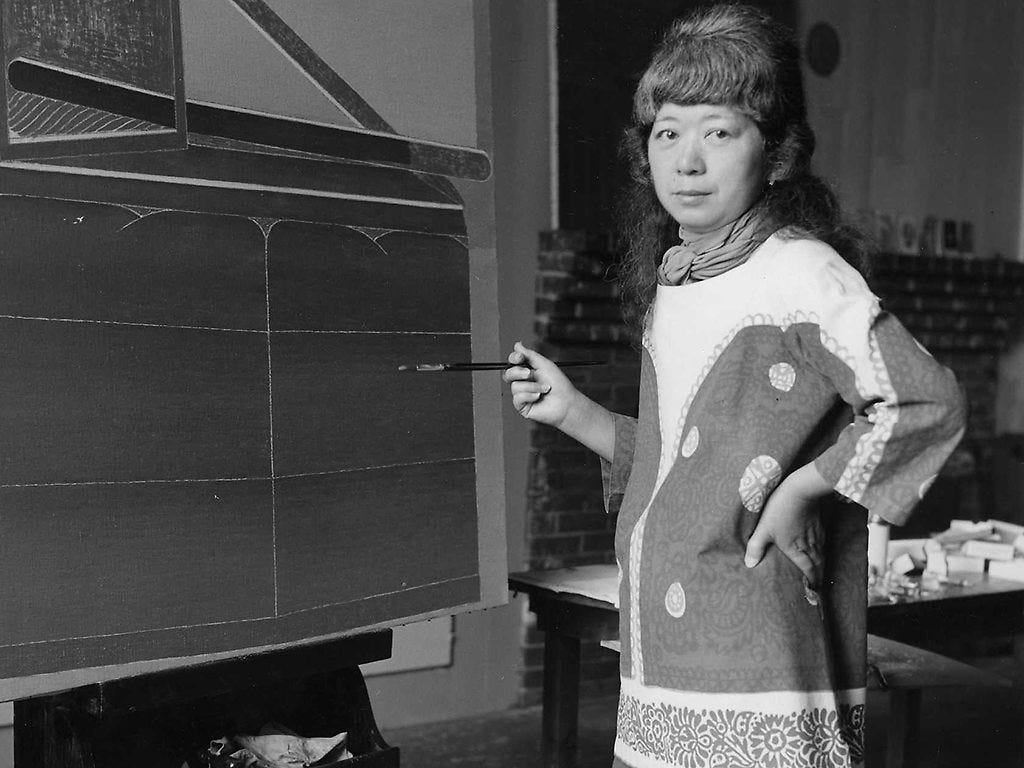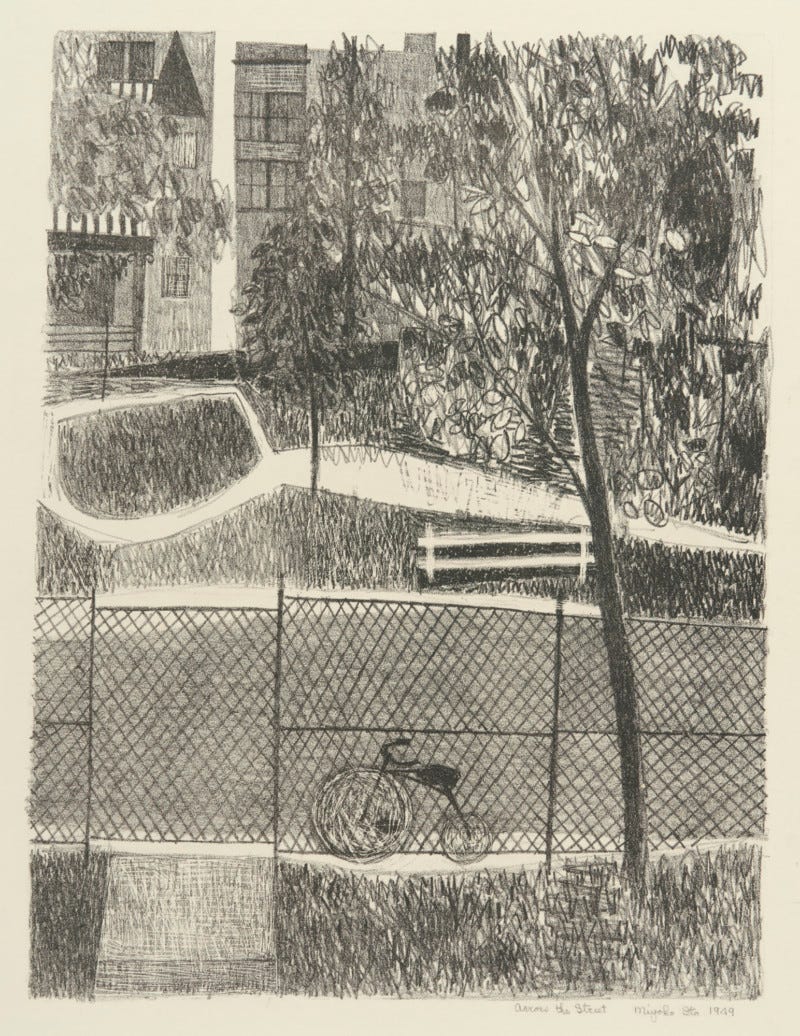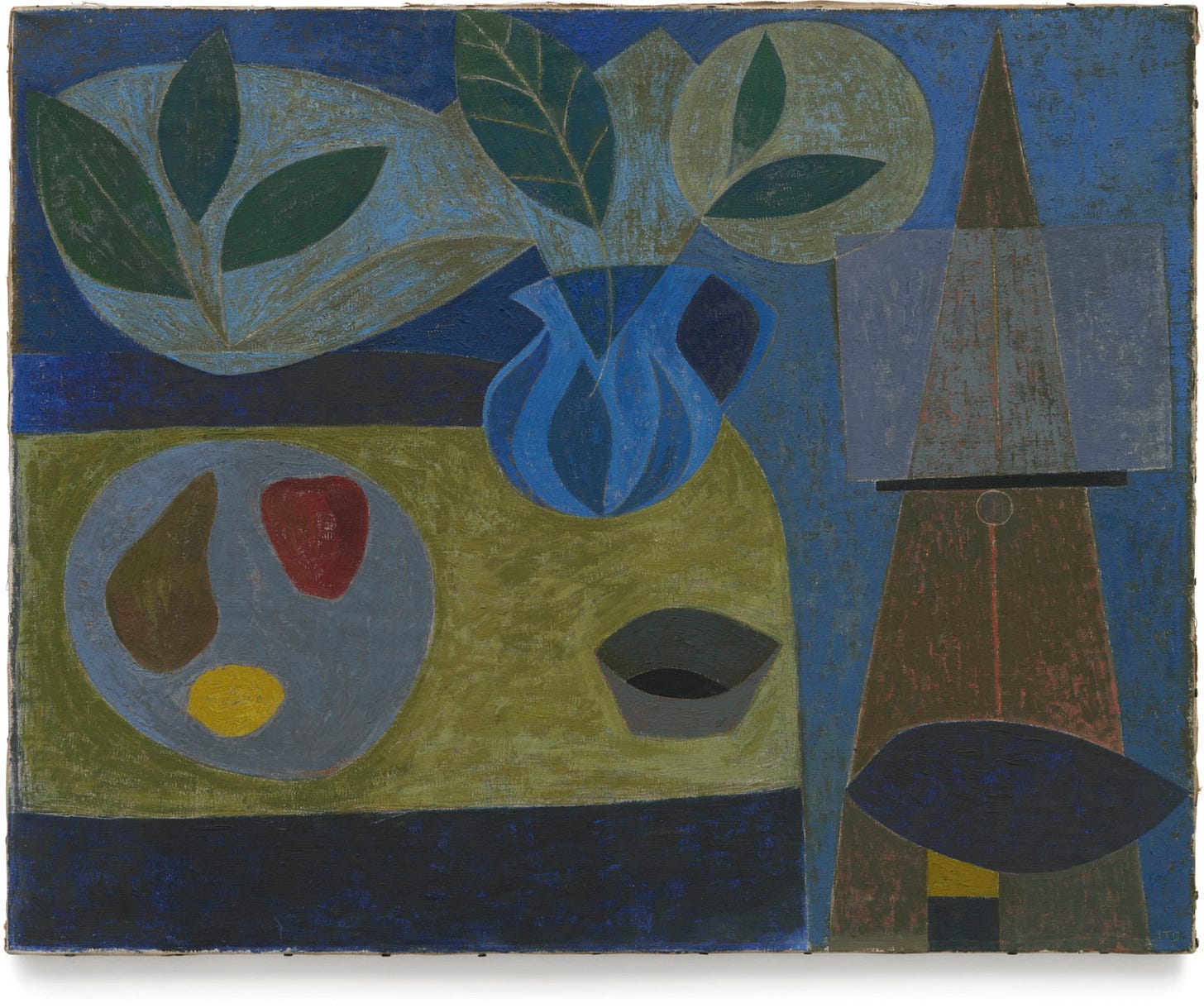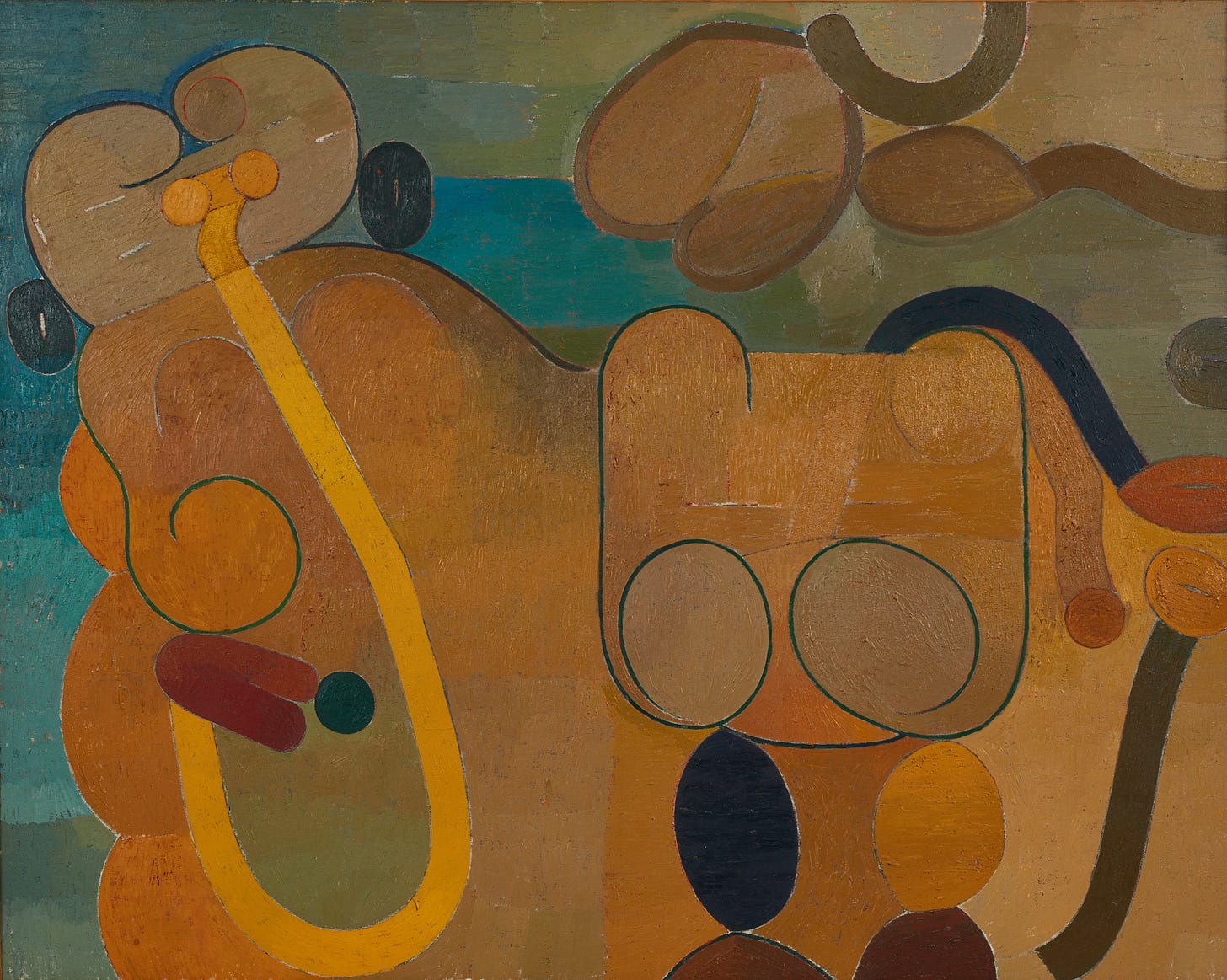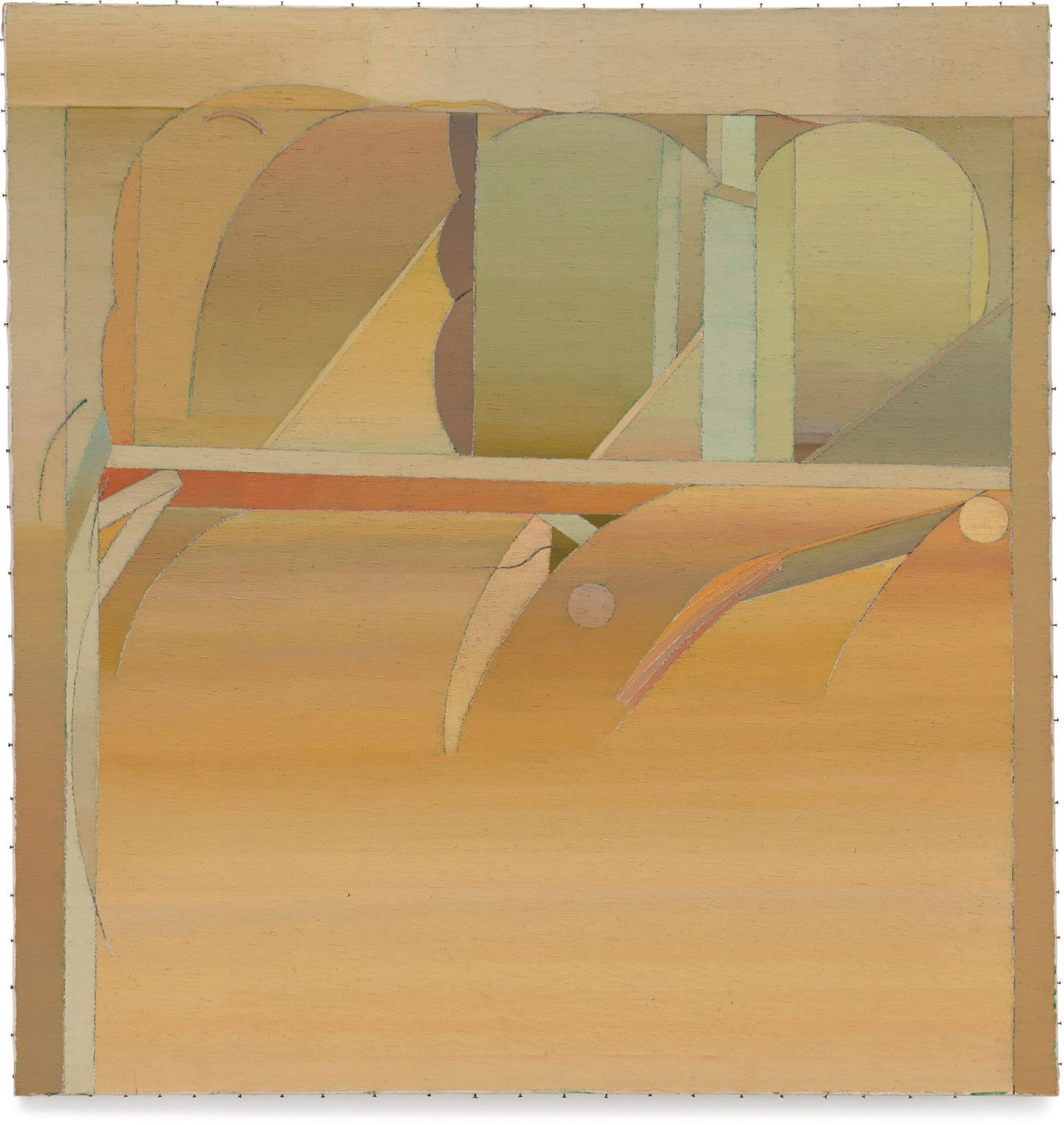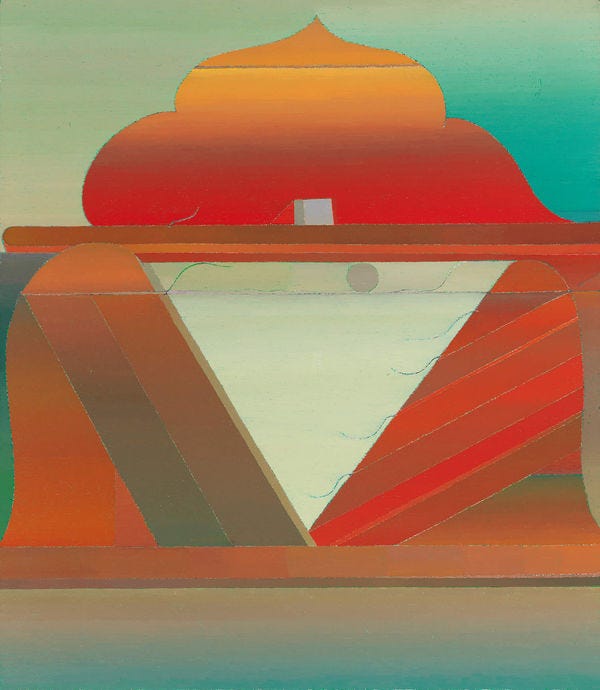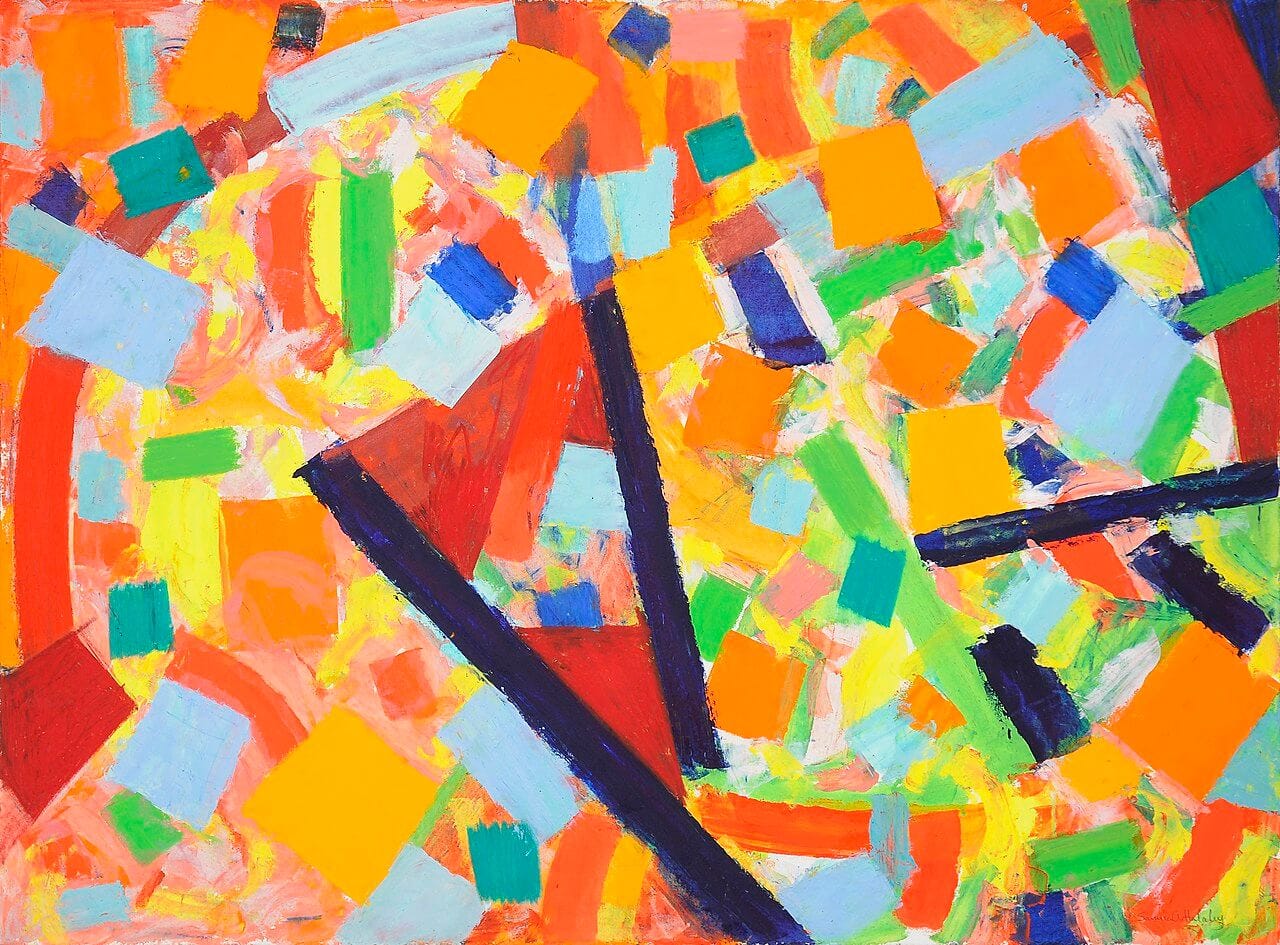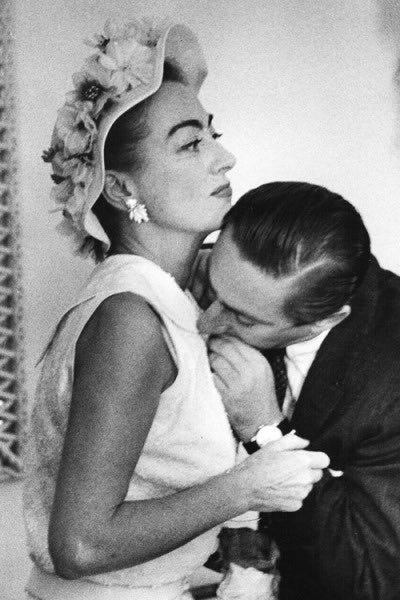Issue 36: "I recognized it that way"
The paintings of Miyoko Ito
I first saw Miyoko Ito’s paintings in 2018, in a small show at Artists Space in New York organized by Jordan Stein. I knew nothing about the artist. I’d seen one painting on an email press release and had the caveman thought that I liked the colours and shapes and that I would enjoy seeing more of them because they suited my mood that day.
I couldn’t pin down what Ito’s paintings reminded me of. The sensation of looking at them was like reaching for a word I knew but couldn’t remember. Something like Penguin paperback editions of Evelyn Waugh from the 1970s (think Art Deco on LSD). Peter Schmidt’s Before and After Science prints made in 1977 for Brian Eno. Photographs of postmodern hotel lobbies. The miniature volcanic landscape of the coal fire in my parents house when I was a child. But also none of those things. Often this sort of inchoate response occurs in the first few seconds of walking into an art gallery and quickly evaporates like fog under a warming sun by reading wall captions, learning the titles and dates, slotting it into little mental boxes. But there is a category of artwork which I can’t explain to others nor rationalize to myself. It speaks to a private space for which either the key is yet to be found or it doesn’t exist or it can’t be made. Art critics rarely write about this feeling, partly because it’s boring for other people, and partly because it embarrasses the professional who has been trained to explain. Yet that’s what I love about those kinds of works. They’re an infinite resource to return to, they never drain of energy, because they draw power from a well that is buried so deep within that even I’m not sure where it’s coming from.
The selection at Artists Space (followed later that year by an exhibition at the Berkeley Art Museum and Pacific Film Archive) mostly dated from the 1970s, the later years of Ito’s life. The palette was warm, with burnt oranges and browns tempered by dirty, acid yellows, mute greens and hot, petroleum blues. Often these colours were modelled with light to dark gradients. Closer inspection showed them to be built on layers of underpainting which Ito allowed to show through at the edges of the shapes she depicted: a pale mint shade might be bordered with a dark emerald tone, or a white would peek from behind a top layer of rusty reds. The underpainting gave the hard edges of her forms a rough quality, like a piece of carpentered wood that hadn’t yet been planed and sanded smooth.
The shapes the colours described were ambiguous. There were irregular geometric solids and lozenges, sharp triangles and bulbous clouds, the occasional wiggly line. Organic in the way that a crystal under a microscope looks organic. They were abstract but seemed to describe a physical space—that’s to say, they weren’t formal like a Piet Mondrian or an Ellsworth Kelly, with the colours and shapes flattened as if they existed in a vacuum, rather they had a sense of air and depth in the same sense that Helen Frankenthaler’s abstractions possess those qualities albeit in a vastly more fluid and loose way. The scale of Ito’s paintings seemed to shift maddeningly within even a single image. Some looked like close-ups of domestic scenes—a section of a dresser and the corner of a mirror, for instance—while others could’ve been landscapes describing vast, ancient cities. They were both claustrophobically close and satellite-high. The titles—Odyssey, Islands in the Sun, Walls of No Escape, Heart of Hearts—were evocative but didn’t give much away. (Certain paintings, I’d later discover, were direct: Work Bench, Dresser, Egyptian Commode. A pair of paintings named after her children: A For Alan and E for Elissa.) Strangely, some of the canvases were attached to their stretchers with tacks that were not hammered flush and left to stand half-an-inch or so from the edge of the picture. This had the effect, to my mind, of making the paintings seem as if they were defending themselves. Not quite wooden stakes or a barbed wire perimeter, more like a prickly pear or a hedgehog.
Ito died of heart failure forty years ago, in 1983, and although she was not unknown in her lifetime—she had an exhibition at the Renaissance Society in Chicago, her adopted home, and was long championed by the dealer Phyllis Kind—she was no household name. In the past two years the work has been seen at blue-chip galleries. There was a show at Michael Werner Gallery in 2022, another at Matthew Marks last year. The small exhibition at Artists Space remained vivid in my memory; it’s hard for me to think of another show of abstract work that’s stayed with me in the past decade like this one did, with the exception perhaps of the first time I saw Ron Nagle’s ceramics. (Another artist whose abstract forms hover tantalizingly on the threshold of figuration.) But I’ve been lazy, and my sense of how Ito’s paintings evolved and what the artist’s story was remained foggy to me.
Stein has now completed Heart of Hearts, a hefty, beautiful monograph on Ito’s work, designed by Grant Schofield, edited by the critic Jennifer Krasinski—one of New York’s sharpest art writers—and published this month by artist Matt Connors’ Pre-Echo Press. The book is the first inventory of Ito’s career, comprising over 200 paintings and drawings, and a major piece of detective work, resulting from years spent hunting down paintings in private collections and museum archives. It’s unclear if they found everything and there may still be pieces hiding in a dusty regional art centre or on someone’s living room wall. There is an entire section of the book scanned from transparencies originally taken by Phyllis Kind Gallery, now in Chicago’s Roger Brown Study Collection, documenting paintings that can’t be located, or may not even exist anymore. (On the acknowledgements page, Stein points out something we often forget when we look at art catalogues—Heart of Hearts isn’t a book of paintings, it’s a book of photographs of paintings.) There’s a small selection of ephemera relating to her career, and—something rarely seen but fascinating—a photograph at the back of the book of a half-finished painting, which gives a glimpse into Ito’s process.
The book is framed by an informative biographical essay and the transcript of an interview Ito gave in 1978. We learn that she was born in 1918, in Berkeley, California to Japanese parents. For financial reasons she moved with her mother and sister to Japan in the early 1920s. It was a formative yet traumatic experience. Ito fell seriously ill and for some time lost the ability to walk. They returned to California in 1928. In the late 1930s, Ito enrolled at U.C. Berkeley to study art. After the bombing of Pearl Harbor, President Roosevelt ordered that all people of Japanese descent in the USA were to be interned in remote camps in the west of the country. Before Ito could graduate, she and her husband were sent to the Tanforan Assembly Center in San Bruno. There she would receive through the mail her diploma, learning that she’d graduated in absentia with flying colours.
After being released from Tanforan, Ito enrolled at the School of the Art Institute of Chicago, and made the city her home. In the late 1940s, under the tutelage of Max Kahn, she experimented with lithography, making street scenes which in turn began to affect the way she dealt with light and tone in her oil painting. In Berkeley she’d been influenced by Cubism. After moving to Chicago, this fused with an interest in surrealism and, perhaps more surprisingly, the intimate domestic spaces of Pierre Bonnard. Her work from the 1950s has none of Bonnard’s bright colour, however. They’re heavy and tonally dark paintings, semi-figurative still lifes, with the occasional collaged element. The effect is like looking at objects hiding in semi-darkness.
Ito spent the 1950s raising her two children, isolated from the Chicago art scene. Stein identifies a painting made in 1959 as a major turning point. In Kalamazoo—a name which pops with pleasure on the tongue—rounded, bubbly forms in shades of amber and ochre bounce around the frame against a lush turquoise, the colour of tropical sea. From here, the light seems to brighten in her paintings, her palette becoming significantly richer throughout the 1960s. The Imagists were one of the main games in Chicago from the 1960s through into the 1970s. Ito was friendly with a number of them, and many were part of Phyllis Kind’s artist roster too. Their grotesque, zany style of figurative painting, which pulled from comic books and the commercial landscape, shares a psychological quality with Ito’s work rather than a formal one; a dreamlike, surrealist sense of space, an unusual attention to pattern and shape-making, a bold use of colour. Her paintings evoke a kind of perceptual flux. Ito once said that “furniture never stays furniture, it turns into landscape or into some kind of action.”
It was during this decade that she established her painting’s key characteristics: stacked bars or lozenges, semi-circles reminiscent of mirrors on a dressing table, isometric shapes that teasingly suggest we might be looking at the interior of a room, or a road crossing a vast distance. Stein aligns her mature work with that of Frankenthaler, Arthur Dove and Giorgio Morandi, noting echoes of Paul Klee. He also relates it to the Japanese aesthetic philosophy of wabi-sabi, whereby imperfection in an image or object is valued for expressing qualities of impermanence and change. The extent to which Japanese art influenced Ito is unclear, as the artist herself said in interview that “content is usually pointed out to me by other people.” Artist Ray Yoshida told her, for instance, that her painting was influence by Heian period work: “And so it was. I recognized it that way.” The poet John Yau posits the idea that the half-nailed tacks around the edges of her paintings related to needing to be ready to pack her bags at a moment’s notice, a nod to her experiences in Japan and the internment camp. Stein points out that the writer Michelle Brandt had discovered they had no such meaning at all. Ito once told a framer to “go ahead and pound them in.”
In her late period, Ito’s colours become duskier. They look like desert paintings. A few works have a gorgeous, pastel lightness to them. Where there is more symmetry in the composition of her earlier works, this is turned over to a complex and busy geography of shapes. But there’s also suggestion of looking through windows or doorways—some almost resemble the reverse of a painting, stretcher bars not window frames—and of gazing into mirrors and empty rooms.
There is an intense feeling of interiority expressed in these paintings. Perhaps what’s attractive to me about them is that they may only be able to exist as paintings, and language cannot touch them. They come close to the condition of music: we can anatomize notes, chords, rhythms, timbres, structural concepts, but that still doesn’t explain the music. Leafing through Heart of Hearts, I noticed something about the development of the work. The early pieces, from the 1950s, look like images made in the first few minutes of dawn, the point of the morning at which the black and blue of night are beginning, ever so slightly, to relent to colour. The paintings brighten significantly in the 1960s: with only a few exceptions they’re have the sense of being made under full sun or something once vivid now bleached out. By the 1970s they hold the temperature of the earth and air at the end of a hot August day. Some blaze like a sunset, others look like they might be cooling in the twilight. It’s as if her body of paintings describe the arc of a day and the arc of a life.
RECOMMENDATIONS
—I’m looking forward to Truckload of Art, The Life and Work of Terry Allen: An Authorized Biography by Brendan Greaves. Allen is the only artist I know of to have had a successful career as both a country & western musician and as a conceptual artist. His album Juarez, made in 1975, is a spare and haunting narrative about a couple on the run in the American Southwest, but the follow-up, Lubbock (On Everything) has the advantage of containing the song ‘Truckload of Art,’ which tells the story a group of New York City artists who drive to California to lord their superior ideas over the artists of the West Coast, only to get involved in a crash, spilling their art across the road. Its chorus goes: “There’s a truckload of art, it’s burning near the highway, precious objects are scattered all over the ground. It’s a terrible sight, if a person were to see it, but there weren’t nobody around.” (You can read a short essay I wrote for frieze on Allen’s work a few years ago here.)
—You’ve probably heard the disgraceful news that Indiana University’s Eskenazi Museum of Art cancelled a retrospective exhibition by the 87-year old Palestinian painter Samia Halaby. A sister exhibition at MSU Broad Art Museum at Michigan State University still looks slated to open this summer. The silver lining is that both institutions—unless the Eskenazi Museum decides to chop the book down the middle—have produced a major new catalogue published by Hirmer and distributed by the University of Chicago Press.
—I was sad to hear that the music critic Neil Kulkarni died suddenly last week at the young age of 51. I first came across Kulkarni’s work in the Melody Maker in the early 1990s, when the British music press weeklies were still in a golden age, publishing entertaining, brainy, and passionate new writing. There, and in his subsequent freelance career, Kulkarni championed hiphop, heavy metal, dance music and the most inventive, unclassifiable bands on the fringes of alternative rock. This piece written in 2011 for TheQuietus about the Birmingham band Pram was typical of his approach: passionate, pugnacious, erudite, and in the best sort of way, completely all-over-the-place.
—Finally I recommend this image of Joan Crawford’s assistant biting thread from her dress at the Dorchester Hotel in 1956.

